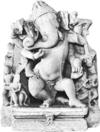- Ganesha
-
/geuh nay"sheuh/, n.the Hindu god of wisdom.
* * *
or GanesaHe is also revered in Jainism, and he is important in the art and mythology of Buddhist Asia. As the remover of obstacles, Ganesha is invoked when beginning worship or starting any new venture. He was popular with Indian nationalists, who saw British colonialism as one obstacle to be removed. The patron of letters and learning, he is the legendary scribe who wrote down the Mahabharata. His popularity continued to grow through the 20th century. His festival is especially popular in the Indian state of Maharashtra. Ganesa dancing, relief from Farrukhabad, Uttar Pradesh, India, 10th century AD; in the State ...Pramod Chandra
Ganesa dancing, relief from Farrukhabad, Uttar Pradesh, India, 10th century AD; in the State ...Pramod Chandra* * *
▪ Hindu deityelephant-headed Hindu (Hinduism) god of beginnings, who is traditionally worshipped before any major enterprise and is the patron of intellectuals, bankers, scribes, and authors. He is also known as “Lord of the People” (gana means the common people) and as “Lord of the Ganas” (Ganesha is the chief of the ganas, the goblin hosts of Shiva). Ganesha is potbellied and generally depicted as holding in his hand a few round Indian sweets, of which he is inordinately fond. His vehicle (vahana) in the world is the large Indian bandicoot rat, which symbolizes Ganesha's ability to overcome anything to get what he wants; Ganesha is thus the remover of obstacles.Many different stories are told about the birth of Ganesha, including one in which Parvati (Pārvatī) makes her son out of a piece of cloth and asks her consort, Shiva, to bring him to life. One of the best-known myths, however, begins with Parvati taking a bath and longing for someone to keep Shiva from barging in on her, as was his habit. As she bathes, she kneads the dirt that she rubs off her body into the shape of a child, who comes to life. But when Shiva sees the handsome young boy—or when the inauspicious planet Saturn (Shani) glances at it, in some variants of the myth that attempt to absolve Shiva of the crime—he or one of his attendants cuts off the child's head, which is eventually replaced with the head of an elephant. When Shiva cuts off the elephant's head to bestow it on the headless Ganesha, one of the tusks is shattered, and Ganesha is depicted holding the broken-off piece in his hand. According to this version of the myth, Ganesha is the child of Parvati alone—indeed, a child born despite Shiva's negative intervention.Wendy DonigerAdditional ReadingPaul B. Courtright, Ganeśa: Lord of Obstacles, Lord of Beginnings (1985), is a comprehensive study of Ganesha and his place in Indian religion and culture.* * *
Universalium. 2010.
